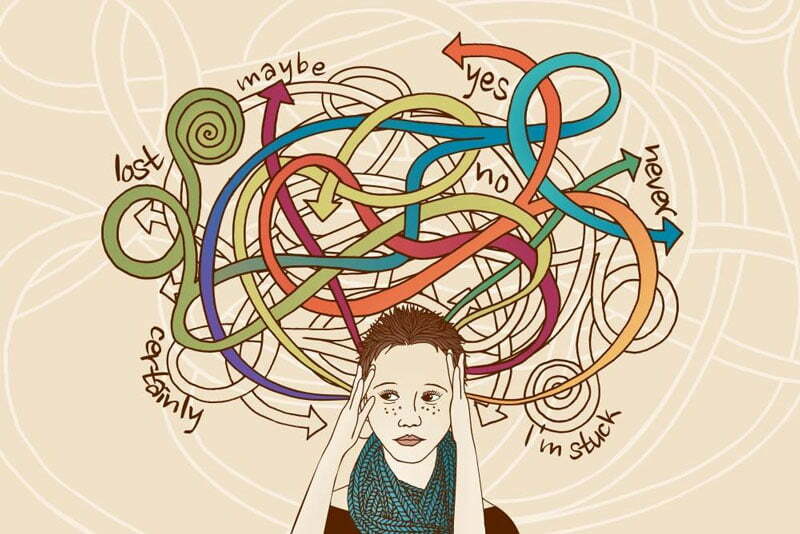
In loving relationships, it is natural to put another’s needs first. Because of this, it can be difficult to tell when putting someone else’s needs first meets the threshold of codependency. As a result, codependency often and unfortunately goes under-recognized as a relationship problem. This is an issue, and more information needs to be readily available about codependency as it can cause an immense amount of suffering to us and our loved ones and jeopardize our ability to have healthy and fulfilling relationships.
What is codependency?
Codependency is common relationship problem characterized by an over reliance on others for approval, self-worth, and a sense of identity (Johnson, 2018). It is a learned pattern of behavior that affects an individual’s ability to have a healthy relationship (Mental Health America, 2018). People who have codependency issues tend to focus on the needs of others, sometimes adopting excessive caretaking roles for their partners, whilst neglecting their own needs (Beattie, 1987; Reyome, Wark, and Witkiewitz, 2010). They tend to orient and organize their thinking and behavior around their partner. At the core of codependency is a lost sense of self and a deficit of self-love (Whitfield, 1991).
How does it arise?
People can develop codependent ways of relating to others as a result of growing up in families of origin where love was conditional, or where they did not get their needs for safety, security, emotional support, nurturance, or emotional expression met as children. There are, unfortunately, many pathways through which this can happen:
- When a family member has substance use issues or a mental health issue: this can lead to a child’s needs being neglected, overlooked, or not consistently met (Reyome, Wark, and Witkiewitz, 2010)
- When children are “parentified”: where children over function, become the “family hero”, or feel compelled to take on a parental role toward their own parent, likely because their own parent did not have their own needs met growing up (Wells, Glickauf-Hughes, and Jones, 1999). In this way, codependency can be transmitted from one generation to another as a way of relating to others (Lampis, Cataudella, Busonera, and Skowron, 2017)
- When families do not talk about problems or emotions: this can result in inhibited emotional and identity development as family members learn to repress emotions and disregard their needs (Mental Health America, 2018)
- When families are very controlling and low in nurturance: this can lead to feelings of low self-worth and the feeling that love is conditional upon them adhering to a set of rules (Reyome, Wark, and Witkiewitz, 2010). It can also inhibit the process of self-differentiation, which is the ability to develop intimate relationships with others whilst remaining independent within them (Chang, 2018)
- When families have an expectation of family members to always be strong, good, perfect, happy: this can lead to unexpressed feelings and hinder emotional development (Whitfield, 1991)
- When families overvalue self-sacrifice: this can lead to family members not being attuned to their own needs
Main consequences
When children do not get their needs met, they learn to suppress and disregard their needs. Overtime, as they continue to repress their own internal cues, they lose contact with and become disconnected from their internal world. They become unable to identify their needs or their feelings or emotions. This impacts their ability to cope with emotions. In parallel, as they turn away from their own needs, they pay attention to the needs of others more, and are often rewarded with love and approval for doing so. This sets them up for a long-standing pattern of allowing others to assume greater importance, trying to get love and care from a difficult person, and neglecting their own needs, thereby stifling their true selves (Whitfield, 1991). As a result, they come into adulthood disconnected from their sense of self, and reliant on others for their sense of self-worth.
This same pattern that helped them survive in childhood prevents them from developing healthy, fulfilling relationships in adulthood. In adult relationships, the codependent person is so busy anticipating and meeting the needs of others that they lose their sense of self and identity in the process. (Henley, 2010). They strive hard to keep everything and everyone under control and feel responsible for everyone. They believe that the needs of others are more important than their own, and struggle to uphold boundaries or communicate how they feel (Henley, 2010). This can lead to stress, anxiety, and depression.
Typical characteristics of people with codependency
People with codependency are externally focused and find it hard to be themselves. They have a need to be liked by everyone. They believe they have to give and sacrifice themselves to get love. They often suppress their emotions and feelings and turn to substances to try to feel better, other compulsive behaviors such as overworking, working out excessively, gambling, or sex. This can lead to substance abuse and intimacy issues.
They often struggle to open up and express their feelings. They have good intentions in trying to care for others but the caretaking often becomes compulsive and self-defeating. They can also use caretaking as a mean to find purpose and may stay in relationships even if they are extremely distressing. They struggle with a lost sense of self, lack self-love, and can often engage in manipulative behaviors to gain control of a relationship in order to feel secure (Ahmad-Abadi et al., 2017).
People with codependency often have difficulty tolerating separation from a partner, even if the relationship is causing personal distress (Lampis, Cataudella, Busonera, and Skowron, 2017). They often feel the need to always be in a relationship, as loneliness is often unbearable for them. They look to their partner to provide a sense of safety and security, and if this is lacking, it results in extreme emotional distress, the pain of which often drives people with codependency issues to behave in compulsive ways to secure their partner’s attention.
Identifying codependency
It can be difficult to identify and draw the line between codependency and caring behaviors, particularly in the context of Asian or other collectivistic cultures which often idealize self-sacrifice and putting other’s first. So, to clarify, codependency does not refer to all caring behaviors or feelings. In loving relationships, it is natural to put others’ needs first, and one can put another person’s needs first without reaching the threshold of codependency; just as sadness does not have to reach the threshold of depression. One way to tell whether a particular behavior is coming out of codependency or caring is to check in with yourself about what the intention is behind the action: codependency is not so much what we do as much as it is why we’re doing it. If the intention is to gain a sense of love and approval that we feel we cannot get elsewhere, it may be crossing into the territory of codependence. However, if our action is simply an expression of love with no strong expectation, it would not be codependence. Another way to make the distinction between caring behaviors and codependence is that healthy empathy and caring comes from a conscious choice, whereas unhealthy empathy and caring may come from a compulsive place where people find it difficult to think through the consequences of their actions or the needs they are sacrificing in order to give care.
Recovery from codependency
Although it can seem like a never-ending cycle of low self-worth, pain, and dependency, recovery from codependency and the cultivation of healthy, self-loved based relationships is possible. Codependency manifests in varying degrees of severity. Recovery from codependency involves getting to know yourself again and reconnecting with your needs. It can be seen as going through a process of self-differentiation, where you learn how to cultivate intimate, emotional relationships with others whilst remaining independent within them (Chang, 2018). Here are some steps you can take to start the process of recovery from codependency:
Step one: Learn about and understand codependency and how it impacts your relationships. The first step in changing unhealthy behavior is to understand it.
Step two: Accept that you do not have the ability to control others and reclaim responsibility and power over yourself: our beliefs thoughts, feelings, decisions, choices, and behaviors (Whitfield 1991). This may include learning to say “no” and finding the balance between being loving and caring but firm and boundary-holding.
Step three: Focus on rediscovering and practicing being your true self. Identify your physical, mental and emotional needs and practice meeting these needs on your own and being self-reliant. When you feel the need to please another person, dig a little deeper.
Since the habits of codependency are so deeply ingrained from childhood, it can be helpful to seek outside help in order to fully recover and get back on track to healthy relating. Working through codependency issues with a therapist will typically involve delving into childhood to talk through and release all the negative emotions that have been bottled up for so long, as well as reconnecting with and relearning to trust the mind or part of self that has been neglected all this time.
If you are interested in scheduling a relationship session with Bhavna Bharvani or have further queries, please contact us today.
References
Ahmad-Abadi, F. K., Maarefvand, M., Aghaei, H., Hosseinzadeh, S., Abbasi, M., & Khubchandani, J. (2017). Effectiveness of Satir-Informed Family-Therapy on the Codependency of Drug Dependents’ Family Members in Iran: A Randomized Controlled Trial. Journal of Evidence-Informed Social Work, 14(4), 301–310.
Beattie, M. (1987). Codependent No More. Center City, MN: Hazelden Educational Materials.
Beattie, M. (2009). The New Codependency: Help and guidance for today’s generation. New York, NY: Simon & Schuster.
Chang, S. (2018). Testing a model of codependency for college students in Taiwan based on Bowen’s concept of differentiation. International Journal of Psychology, 53(2), 107–116.
Henley, J. M. (2010, July 28). What is codependency? An introduction. Retrieved from https://www.goodtherapy.org/blog/what-is-co-dependency/
Johnson, R. S. (2018, October 6). Codependency and codependent relationships. Retrieved from https://bpdfamily.com/content/codependency-codependent-relationships
Knudson, T. M., Terrell, H. K. (2012). Codependency, Perceived Interparental Conflict, and Substance Abuse in the Family of Origin. American Journal of Family Therapy, 40(3), 245-257.
Lampis, J., Cataudella, S., Busonera, A., & Skowron, E. (2017). The Role of Differentiation of Self and Dyadic Adjustment in Predicting Codependency. Contemporary Family Therapy: An International Journal, 39(1), 62–72.
Mental Health America (2018, n.d.). Co-Dependency. Retrieved from http://www.mentalhealthamerica.net/co-dependency
Reyome, N. D., Ward, K. S., & Witkiewitz, K. (2010). Psychosocial Variables as Mediators of the Relationship Between Childhood History of Emotional Maltreatment, Codependency, and Self-Silencing. Journal of Aggression, Maltreatment & Trauma, 19(2), 159–179.
Wells, M., Glickauf-Hughes, C., & Jones, R. (1999). Codependency: A grass roots construct’s relationship to shame-proneness, low self-esteem, and childhood parentification. The American Journal of Family Therapy, 27(1), 63-71.
Whitfield, C. L. (1991). Co-dependence: Healing the human condition: The new paradigm for helping professionals and people in recovery. Deerfield Beach, FL: Health Communications, Inc.

